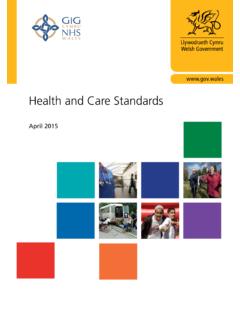Transcription of the diabetes epidemic and its impact on Europe - …
1 The diabetes epidemic and its impact on EuropeJ rg FrEitagJ rg has type 2 diabetes23*the document predominantly focuses on type 2 diabetes , unless otherwise SUMMarYMost healthcare systems today are organised to treat the acute symptoms of disease and manage conditions separately. We are less advanced when it comes to integrated prevention efforts, early detection, care and treatment for chronic non-communicable diseases. an integrated patient-centred approach will capitalise on common treatment needs and thus have a greater impact . this book sets out a number of key steps, which could help tackle the epidemic development of type 2 diabetes while having a potentially far-reaching impact on the overall development of chronic ty pe 2 diabetes shares several modifiable risk factors with other chronic diseases, and targeting these risk factors through general health promotion.
2 Awareness and direct intervention can prevent or delay the onset of diabetes *Early detection Early detection and treatment can improve the outlook for people with type 2 diabetes and other chronic diseases, since timely control decreases the risk of complicationsMuch progress has been made in recent years, but there is still room for improvement in tackling the growing diabetes challenge in Europe . Successfully controlling type 2 diabetes will significantly contribute in the prevention of other chronic diseases, due to their shared risk factors, underlying determinants and opportunities for management People with well-controlled diabetes achieve better outcomes.
3 A patient-centred approach to care involving monitoring, and collecting of outcomes data can help keep people with chronic diseases healthierthrough all of the phases of prevention, early detection and improved management, a coordinated approach involving public and private partners is needed. the diabetes epidemic and its impact on Europe begins with a discussion on chronic diseases and the value of prevention, and outlines the startling extent of diabetes in Europe . Following this, the benefits of early detection and the need for education and data collection are introduced.
4 The book then stresses the importance of women and children s health and showcases good practice examples. as the case for urgent action has been made, potential next steps are then defined. Finally, the complications and burden of diabetes are ECkandreas has type 2 diabetes4*the data presented in this book are, in general, based on Europe , defined as: albania, austria, Belgium, Bosnia-Herzegovina, Bulgaria, Croatia, Cyprus, Czech republic, denmark, Estonia, Finland, the former Yugoslav republic of Macedonia, France, germany, greece, Hungary, iceland, the republic of ireland, italy, kosovo, Latvia, Liechtenstein, Lithuania, Luxembourg, Malta, Montenegro, the netherlands, norway, Poland, Portugal, romania, Serbia, Slovakia, Slovenia, Spain, Sweden, Switzerland, turkey and the diabetes Leadership Forum* across Europe , and within the institutions of the European Union (EU)
5 , declarations have been made that reflect the growing awareness of the challenge of diabetes and other chronic diseases. the need to act to address the substantial and growing human and societal burdens of these diseases has moved significantly up the political agenda. Under the auspices of the danish presidency of the Council of the EU and the danish Ministry of Health, political and healthcare leaders from across Europe will come together at the European diabetes Leadership Forum taking place in Copenhagen on 25 26 april 2012 to discuss what more needs to be done to tackle chronic European diabetes Leadership Forum is hosted by the Organisation for Economic Co-operation and development (OECd) and the danish diabetes association.
6 Novo nordisk is proud to support the conference. novo nordisk has also supported the development of this book. as effective interventions exist for the prevention and control of chronic diseases such as diabetes , the evidence investigated and summarised in this book aims to provide payers, policymakers, patient associations, the expert community, and other stakeholders at the European and national level with a clear demonstration of the challenges presented by diabetes and possible solutions. the book s development would not have been possible without the support from and contributions of its editors: Prof Bertrand Cariou, dr david Eddy, Prof Janusz gumprecht, dr richard kahn, dr antonio nicolucci, Prof Peter Schwarz, dr Ulf Smith, Prof nick Wareham and dr daniel Witte.
7 All editors chose to donate their time and resources without compensation to increase awareness of diabetes . although the editors have made every reasonable attempt to achieve complete accuracy of the content in this book, they assume no responsibility for errors or omissions. Furthermore, their personal involvement does not mean that the book reflects the opinions and beliefs of their is hoped that this book will contribute to the development of sustainable improvements in diabetes prevention and detection, and the provision of affordable, effective care throughout COStaalexandra has type 1 diabetes5 COntEntSan integrated approach to chronic diseases Prevention provides the greatest potential for gain diabetes in EuropeHow can we change the future for diabetes in Europe ?
8 Improving outcomes by early detectionPatient self-management education and supportEffectively measuring and sharing data can improve outcomesWomen, diabetes and the next generationSharing experiencesFrom policy to actionWhat needs to change?about diabetesdiabetes affects at every levelEditorial boardreferences1357911131524681012146rOg riO SiLVarog rio has type 2 diabetes7the burden of chronic diseasesChronic diseases are one of the greatest challenges for Europe . the most common of these diseases are cardiovascular disease (heart disease and stroke), cancer, respiratory disease and diabetes1, and together they account for a substantial proportion of total mortality an intEgratEd aPPrOaCH tO CHrOniC diSEaSESU sing an integrated approach to treating and managing diabetes , and other chronic diseases, allows for a greater disability in Europe .
9 Indeed, the vast majority of deaths and disease burden* in Europe are due to non-communicable integrated approach to chronic disease managementan integrated approach is necessary with chronic diseases because many people have more than one of these diseases. in Europe , 35% of men aged over 60 years have two or more chronic with multiple chronic conditions will require multiple ongoing interactions with the healthcare system . Healthcare systems have traditionally been organised around managing each condition separately. However, an integrated patient-centred approach will capitalise on common treatment needs and thus have a greater impact .
10 In the case of type 2 diabetes treatment, research has shown the benefits of an integrated approach. intensifying treatment to include tight control of multiple diabetes risk factors such as high blood glucose, blood pressure and cholesterol have been found to significantly reduce the risk of death from cardiovascular causes and the development of end-stage renal disease5. *the burden of disease measures the impact of a disease or health condition. the World Health Organization measures the burden of disease in a combined mortality and morbidity measure called disability-adjusted life years (daLYs).

















